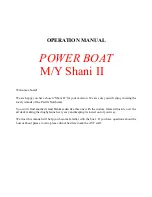
92
Electrical System
WARNING
ELECTRIC SHOCK CAN CAUSE SEVERE INJURY OR EVEN
DEATH. DO NOT ATTEMPT TO CORRECT THE WIRING
YOURSELF. ALWAYS HAVE A QUALIFIED ELECTRICIAN
CHECK WIRING.
KEEP CHILDREN AWAY FROM ANY ELECTRICAL CABLES OR
EQUIPMENT AND ALWAYS USE GROUNDED APPLIANCES
ON BOARD YOUR BOAT.
WARNING
UNDETECTED FAULTS IN THE AC ELECTRICAL SYSTEM
COULD CAUSE THE WATER AROUND THE BOAT TO BECOME
ENERGIZED. THIS COULD CAUSE A SEVERE SHOCK OR
EVEN DEATH TO SOMEONE IN THE WATER NEAR THE
BOAT. NEVER SWIM OR ALLOW SWIMMING AROUND THE
BOAT WHEN THE AC SYSTEM IS ACTIVATED BY THE SHORE
POWER CONNECTION OR GENERATOR.
Disconnecting procedure for shore power
connection:
Deactivate all AC accessory circuits. Turn the
Shore Power main breaker at the AC distribution
panel OFF, then turn the shore power inlet panel
main and the dockside outlet circuit breakers to
the OFF position.
Disconnect the cables from the dockside outlets
and replace the outlet caps. Disconnect the cables
from the boat and close the outlet caps. Store
cables.
If your boat is equipped with the optional power
cord reel, press the top of the SHORE POWER
REEL rocker switch to retract the shore power
cord into the inlet hawse pipe. Close and secure
the hawse pipe cap.
AC Main Distribution Panel
The AC distribution panel is located in the cabin
near the door. The following is a description of
the distribution panel equipment and the breakers
that protect the accessories.
AC Volt Meters
Phase 1 and Phase 2 volt meters monitor the volt-
age for each phase when the boat is connected to
AC power. The voltage should be checked each
time the AC system is activated. The AC system
and accessories can be damaged by voltage that
is below 105 volts or above 125 volts in either
phase. You should monitor the voltage and never
operate your AC electrical system if the voltage is
below or above this range.
The amp or current load should be calculated,
particularly when operating the air conditioner
and optional cockpit cooler/freezer. You should
always be aware of the electrical load needed to
activate accessories and manage the amperage
being supplied so the load can be kept within
safe limits. Avoid excessive current load that
can overload the circuits or the generator. If you
have any questions about managing the power in
your boat, contact your authorized Scout dealer.
Shore Power and Generator Main Breakers
These circuit breakers select the power source and
protect the general distribution network. There is
a main breaker for the shore circuit and the gen-
erator. The Shore Power breaker is equipped with
a relay that will cause the breaker to trip when
reversed polarity current is detected.
The breakers are equipped with a sliding safety
cover to prevent activating the breakers for the
generator and shore circuits simultaneously. The
main breakers must be in the OFF position before
the sliding cover can be moved.
These breakers are very sensitive. The resulting
power surge that occurs when connecting the
dockside cord may cause the main breaker to
trip. To avoid this surge, always turn the Shore
main breaker to the OFF position before plug-
ging or unplugging the shore power cord and the
Generator main breaker to the OFF position when
starting the generator.
Care must be taken when operating the AC system
from the generator or the shore power supply line.
In some situations it may be possible to overload
the generator or shore power circuit if too many
AC accessory breakers are activated. Too much
amperage being supplied through the panel will
cause the main breakers to trip and could damage
the system. This is particularly important when
operating the air conditioner, water heater, elec-
tric grill, ice maker, SeaKeeper and other optional
accessories that may be on your boat that draw
high amperage. You should always be aware of
the electrical load needed to activate accessories
and manage the amperage being supplied so the
load can be kept within safe limits.
The table at the end of this section will assist you
in documenting the load AC accessories on your
boat require and managing the electrical load
https://www.boat-manuals.com/
Содержание 380 LXF
Страница 2: ...2 Rev 0 Print Date 8 10 2017 https www boat manuals com ...
Страница 8: ...8 NOTES https www boat manuals com ...
Страница 14: ...14 NOTES https www boat manuals com ...
Страница 20: ...20 NOTES https www boat manuals com ...
Страница 28: ...28 NOTES https www boat manuals com ...
Страница 31: ...31 Operation https www boat manuals com ...
Страница 58: ...58 NOTES https www boat manuals com ...
Страница 116: ...116 NOTES https www boat manuals com ...
Страница 120: ...120 NOTES https www boat manuals com ...
Страница 156: ...156 NOTES https www boat manuals com ...
Страница 164: ...164 NOTES https www boat manuals com ...
Страница 186: ...186 NOTES https www boat manuals com ...
Страница 191: ...191 191 Appendix C Maintenance Log Date Hours Dealer Service Repairs https www boat manuals com ...
Страница 192: ...192 Maintenance Schedule Log Date Hours Dealer Service Repairs https www boat manuals com ...
Страница 193: ...193 Maintenance Schedule Log Date Hours Dealer Service Repairs https www boat manuals com ...
Страница 194: ...194 Maintenance Schedule Log Date Hours Dealer Service Repairs https www boat manuals com ...
Страница 195: ...195 Maintenance Schedule Log Date Hours Dealer Service Repairs https www boat manuals com ...
Страница 196: ...196 Maintenance Schedule Log Date Hours Dealer Service Repairs https www boat manuals com ...
Страница 197: ...197 197 Appendix D Boating Accident Report https www boat manuals com ...
Страница 198: ...198 Boating Accident Report https www boat manuals com ...
Страница 199: ...199 Boating Accident Report https www boat manuals com ...
Страница 200: ...200 NOTES https www boat manuals com ...
Страница 202: ...202 NOTES https www boat manuals com ...
Страница 209: ...209 https www boat manuals com ...
Страница 210: ...210 Scout Boats Inc 2531 Hwy 78 West Summerville SC 29483 https www boat manuals com ...
















































